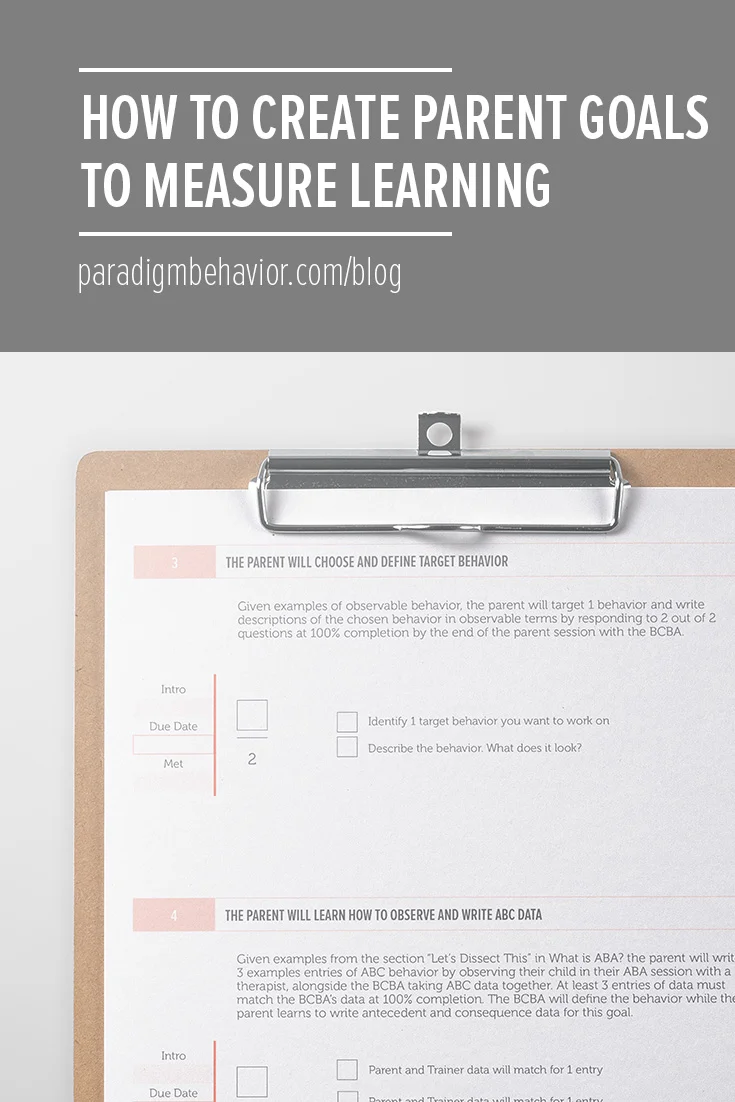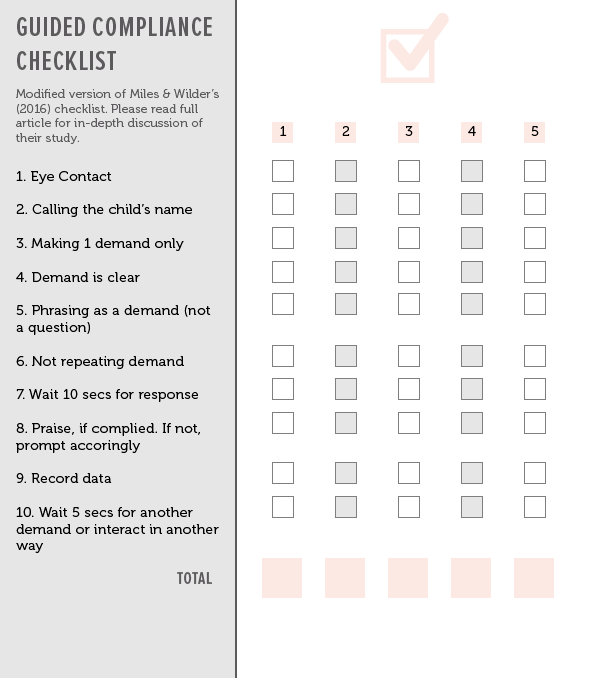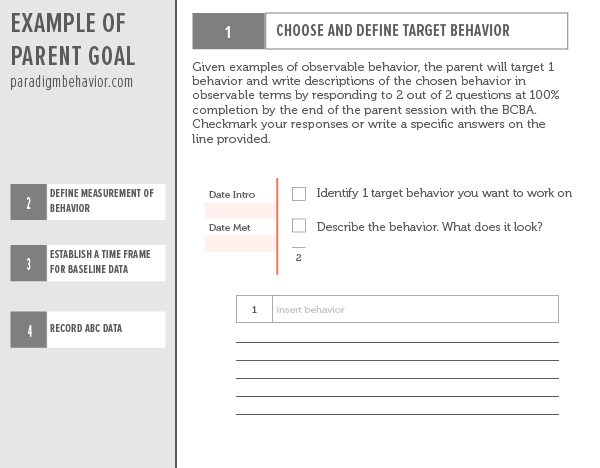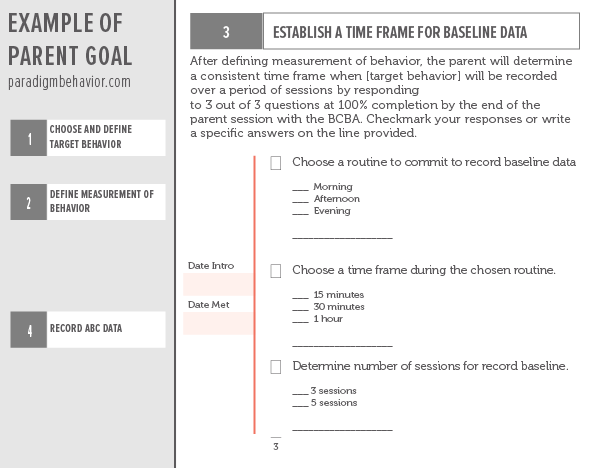The past few months I’ve been a little obsessed with writing appropriate goals for parents. Parent training goals are becoming more relevant to child behavior plans, and it appears insurance companies are taking more of an interest in the role of a parent. To be honest, I found parent goals hard to write; however, I love being involved with parents because of the relationships we create and the progress we make together. For me, parent goals were hard to write because it was difficult to measure progress. Parents made progress by attending parent sessions where we went over basic ABA concepts, but I wasn’t quite sure how to measure their ability to learn and apply them. I realized my mistakes when re-evaluating the goals I’d written because they either weren’t specific enough or my expectations were too high for a parent, making the goal unachievable. I wanted to show parents (and payers) that they were making progress with every parent session
SMART goals are not new. I was first introduced to SMART goals when conducting performance reviews for staff. I also use SMART goals to achieve my own personal goals. It made sense to apply the same knowledge to parent goals, because doing so helped me focus on making these goals achievable. The last thing I would want are for parents to feel like they aren’t reaching their goals. Here’s an overview of SMART goals:
S | specific
Be specific in the behaviors you are targeting. Are you working to reduce problem behavior? Are you teaching 1 word requests (mands)? The more specific you are, the better.
M | measurement
How will you measure progress? Think about the specific behavior you just identified and how would you break it down to show improvement?
A | achievable
What are the steps to achieve this goal?
R | realistic
Make this goal happen. Individualize the goal to the parent and child relationship and make sure they are equipped to perform and follow through.
T | time-bound
Set dates to assess the goal so we can see how much progress we’ve made.
Here’s an example of where I made a couple mistake:
Goal: To expand use of verbal utterances. Using delay prompts or partial/full verbal prompts, parent will reinforce 3+ words when child is requesting for desired items.
S | reinforce 3+ words to request (with desired items)
M | no measurement such as number of opportunities, sessions or time-sample
A | parent will use delay, partial and full verbal prompts
R | child is able to string 3+ words in therapy, but only 1 word at home with parent
T | no time frame (shame on me)
Here’s another goal I found with missing information:
Goal: Parent will require their child to participate in non-preferred self-care tasks, 80% of opportunities, outside of session.
S | non-preferred, self-care tasks. Be more specific, like toothbrushing or putting on pants.
M | how many opportunities outside session? Full or partial participation?
A | parent will require, but what are the steps for participation?
R | is it realistic to work on all non-preferred tasks or should we focus on 1-2 tasks?
T | no time frame
I found a well written article by Adrienne Fitzer to write SMART goals for parents. She’s very specific in her examples for the child, parent, and trainer. All 3 work congruently with each other. Here’s an example of a goal she used for a parent:
Sample Goal: “After two 1:1 parent training sessions, parent will prompt and reinforce child during washing face instruction & implement error correction procedure, if necessary”
Sample Objective: “The parent will deliver reinforcers correctly, (as specified in program) 2/2 opportunities when the trainer is present, during washing face instruction with child...to be completed over a 3 week period after trainer goals are completed.”
S | prompt and reinforce during washing face instruction
M | 2 out of 2 opportunities with trainer (for all objectives under the goal)
A | after two 1:1 parent sessions, parent will prompt and reinforce
R | series of objectives to address face washing across 3 people
T | training completed over 3 weeks, child goals begin on 1st day of parent training
This is a lot of information and specific enough for me to understand what’s going on. Fitzer lists a total of 3 goals with 4-5 objectives across 3 people addressing one behavior (face washing). She addresses all aspects for the parent to learn behavior concepts by the trainer, teach a skill to the parent (and child), and reinforce the behavior at home.
I appreciate her ability to write in goals for the parent to learn behavior concepts during parent training sessions, and she even specifies the time frame (five 1 - 1.5 hour sessions over a 3 week period). Wow! Since I am passionate about providing parent education, I want to be able to measure parent’s progress with learning ABA concepts and, more importantly, help them become comfortable with the technical language they hear when discussing their child’s program with their ABA team.
I did some digging for research articles and found an excellent read by Miles & Wilder (2009) where they taught parents how to follow through with non-compliance. The authors used behavior skills training (BST) during parent training to teach, model, role-play and offer feedback. What drew me to the article is how the authors broke down the steps for the parent in the form of a checklist to measure the parent’s consistency (fidelity) when implementing the procedure. The procedure had 10 components, such as making eye contact, giving a clear demand (not phrasing as a question), waiting 10 seconds for a response,etc. The steps were very concise,and through parent training, each parent in the study scored at least 90%. Talk about consistency! This study showed that parents are capable in learning and applying their behavior training.
By combining SMART goals and a fidelity checklist, I wanted to be able to apply these measurements of goals to parents’ initial training in ABA concepts, such as the ABCs of behavior, prompts, and reinforcement. Here’s an example using my Roadmap to ABA Parent Training, What is ABA?
“Given examples of observable behavior, the parent will target 1 behavior and write descriptions of the chosen behavior in observable terms by responding to 2 out of 2 questions at 100% completion by the end of the parent session with the BCBA. Checkmark your responses and write specific answers on the line provided”
S | choose and define 1 behavior to target for ABC data collection
M | 2 out of 2 questions at 100% completion
A | given examples of observable behavior by BCBA and/or Parent Guide
R | choosing 1 problem behavior of concern to practice and understand antecedents and consequence (instead of focusing on all behaviors)
T | by the end of the parent session, or set an actual deadline for completion
“After defining measurement of behavior, the parent will determine a consistent time frame when [target behavior] will be recorded over a period of days (sessions) by responding to 3 out of 3 questions at 100% completion by the end of the parent session with the BCBA. Checkmark your responses or write specific answers on the line provided”
S | Define “time frame” by time of day, duration and number of days
M | Complete all 3 items at 100% completion
A | Parents are given examples of a time frame
(e.g. Tues/Thurs after snack time for 15 mins for 3 days)
R | Parents making the decision when they are able to take data
T | Make a decision of a feasible time frame at the end of parent session or set an actual deadline
Adding parent goals to instructional material (such as the Parent Guides) adds more value to the parent’s understanding of ABA concepts. Even though the checklists appear simple, they make the instructional material actionable and make parents more familiar with the terminology. So, when a parent hears a therapist say, “[child] swiped his toys off the table as means of escape when I gave the demand to imitate me clapping my hands. I used full physical prompts to clap his hands and then used gestural prompts for him to pick up his toys before moving on. Other than that we had a pretty good session,” parents are able to follow along and know:
Function | escape
A | [Antecedent] gave the demand to imitate clapping hands
B | [Behavior] swiping table
C | [Consequence] therapist provided prompts to clap hands
Did you catch all of that? That’s why I believe it’s important to set the foundation and teach basic ABA concept to parents so when other skills like mand training and self-help tasks are taught, parents are more equipped to read, understand, and follow through with the behavior plan. Also, parent sessions could be more devoted to the teach, model, role-play and offer feedback model.
The Roadmap To ABA Parent Training now includes updates to What is ABA? and Prompts with Adrienne Fitzer, M.A., BCBA. Read more about the Roadmap here.
3 Parent Guides (PDF Booklets): all three topics
What is ABA? (ABCs of Behavior)
Mand Training
Prompts
3 sets of Smart Goals (PDF Booklets)
3 Workbooks (PDF Booklets)
3 Progress Trackers (MS Excel)
References:
Fitzer, A. (2014. June 2). Writing goals and objectives for parent training. Retrieved from https://www.linkedin.com/pulse/20140602160213-50566138-writing-goalsand-objectives-for-parent-training
Miles, N.I. & Wilder, D.A. (2009). The effects of behavioral skills training on caregiver implementation of guided compliance. Journal of Applied Behavior Analysis, 42, 405-410.






